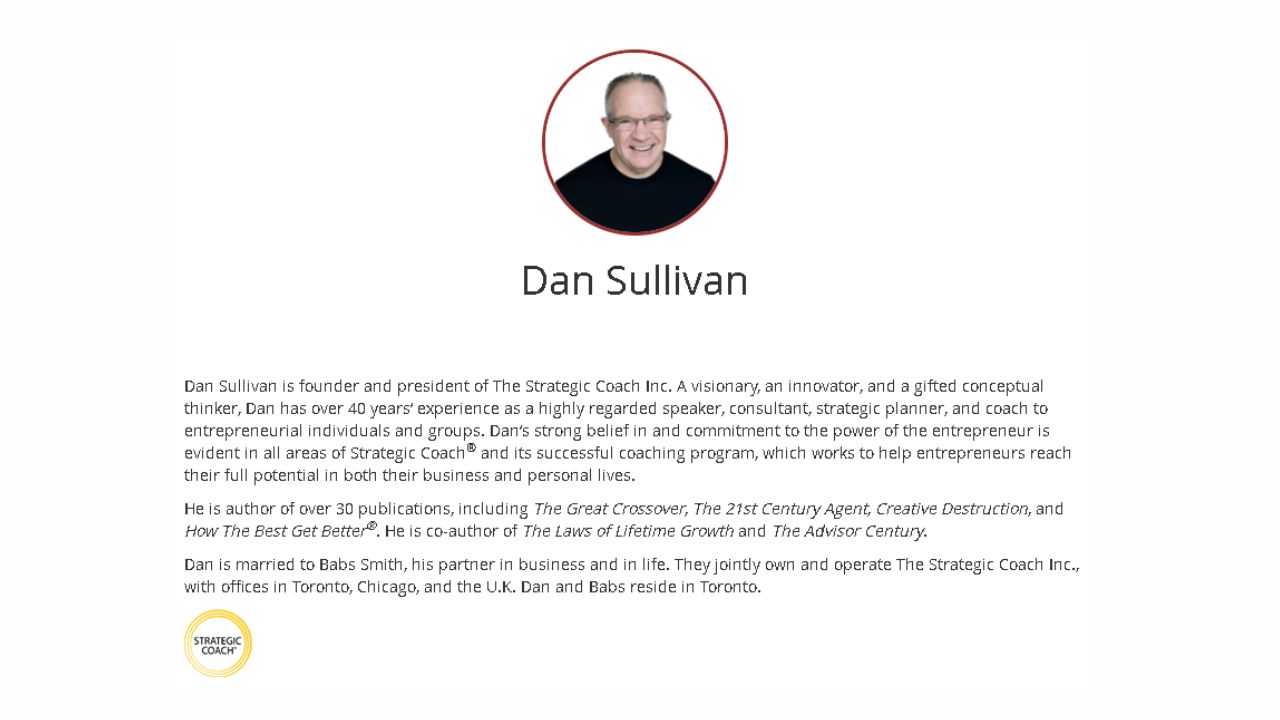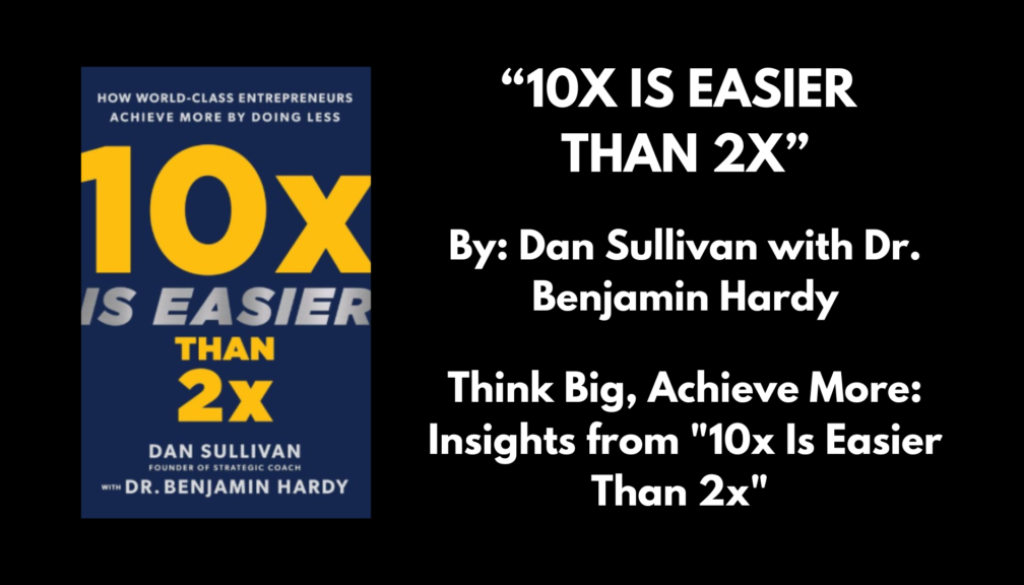Think Big, Achieve More: Insights from “10x Is Easier Than 2x”
Dan Sullivan and Dr. Benjamin Hardy’s book, “10x is Easier than 2x,” emphasizes the importance of thinking bigger and setting audacious goals.
This mindset shift is essential for achieving significant success. The book challenges readers to move beyond incremental improvements and to adopt a mindset that allows for exponential growth. Unlike Grant Cardone’s philosophy, which focuses on quantity and frequency, this book emphasizes quality and leverage. Cardone’s approach, popularized through his book “10X Rule,” revolves around the idea of massive action to achieve massive results.
In contrast, Sullivan and Hardy argue that aiming for 10x growth requires a strategic focus on fewer but more impactful activities, making it a valuable read for those aiming for substantial growth.
Main Thesis
10x Mindset:
The core idea behind the 10x mindset, as presented in “10x is Easier than 2x,” is to set out to achieve something far beyond anything you’ve ever done before by setting achievable goals that push your limits.
This involves setting big, audacious goals that require nonlinear progress. By aiming for goals that seem almost unattainable, you force yourself to think differently and to come up with creative solutions that you wouldn’t consider if you were only aiming for incremental improvements. Achieving goals in this manner brings a sense of satisfaction and progress.
Instead of incremental progress (2x mindset), which involves doubling effort for double output, the 10x mindset focuses on leveraging unique strategies to achieve massive gains with less effort.
This approach emphasizes the importance of quality over quantity and encourages finding high-leverage activities that can significantly multiply results. Setting specific and challenging goals can inspire and motivate, leading to increased performance and a sense of achievement and confidence.
Quote: “Going 10x requires a different kind of thinking. It’s about quality, not quantity.” This underscores the need to focus on impactful actions rather than just increasing the volume of work.
Challenges of Incremental Improvement
Difficulty of 2x Improvements:
Incremental improvements are challenging because they often require putting in more energy and hours.
This linear approach can be exhausting and inefficient. The traditional 2x mindset is rooted in the idea that to achieve more, you simply need to do more, which can lead to burnout and diminishing returns. Instead, focusing on making progress through measurable goals and effective systems can provide a clearer path to success.
When aiming for 10x, the focus shifts to finding leverage points, hacks, and tricks that enable significant impact without necessarily increasing the workload. This shift in perspective allows for smarter, not harder, work.
Quote: “2x is linear; 10x is exponential. Linear progress is predictable and requires doubling effort, but exponential growth leverages creativity and innovation.” This highlights the fundamental difference between incremental and exponential thinking.
The 10x mindset, as detailed in “10x is Easier than 2x,” revolves around the concept of achieving exceptional goals by thinking and acting differently.
This mindset encourages setting big goals that go far beyond your current achievements, pushing you to explore new possibilities and strategies. By aiming for goals that seem almost unattainable, you force yourself to think creatively and develop innovative solutions that you wouldn’t consider with more realistic goals. Instead of focusing on incremental progress, which is characteristic of a 2x mindset, the 10x approach leverages unique strategies to achieve massive gains with less effort.
This requires identifying and pursuing high-leverage activities that can multiply your results significantly.
For instance, setting SMART goals (Specific, Measurable, Achievable, Relevant, Time-bound) ensures that your objectives are clear and achievable, driving you towards consistent progress and ultimate success. Goal setting is crucial in this process. By establishing specific goals and creating a detailed goal setting process, you can break down your ambitious objectives into manageable steps.
This not only makes your goals more attainable but also keeps you motivated and focused.
For example, setting performance goals and regularly tracking your progress helps you stay on the right path, ensuring that every action you take aligns with your end destination. The 10x mindset emphasizes the importance of quality over quantity. Instead of spreading yourself thin across many tasks, focus on doing fewer things exceptionally well.
This involves careful consideration of where to invest your time and energy, ensuring that each action contributes significantly to achieving your goals.
By setting challenging goals that inspire and motivate, you can boost your performance and achieve greater success. In contrast, the 2x mindset involves incremental improvements, which can be exhausting and inefficient. Doubling your efforts for double output often leads to burnout and diminishing returns.
The traditional approach to goal setting in this mindset is to simply do more to achieve more, but this is not sustainable in the long run.
When aiming for 10x, the focus shifts to finding leverage points, hacks, and tricks that enable significant impact without necessarily increasing the workload. This shift in perspective allows for smarter, not harder, work. By identifying measurable goals and focusing on outcome goals, you can ensure that your efforts lead to substantial progress and success.
Setting goals that are ambitious yet achievable is key.
This involves creating an action plan that outlines the steps needed to reach your ideal future. Whether it’s in your professional life or personal pursuits, having a clear roadmap helps you stay focused and motivated. For instance, if you aim to lose weight, setting a specific, time-bound goal with measurable milestones can keep you on track and motivated.
In your professional life, setting team goals and aligning them with your organizational objectives can drive collective success.
By fostering a culture of goal setting and achievement, you can create a motivated and high-performing team. Effective goal setting involves regularly reviewing and adjusting your goals based on progress and external factors, ensuring that you stay on track towards your overall goal. By embracing the 10x mindset and focusing on effective goal setting, you can achieve significant success and transform your approach to achieving goals.
This mindset not only helps you set and achieve ambitious objectives but also inspires you to think creatively and leverage unique strategies for exponential growth.
Focus and Attention
Attention as a Bottleneck
Attention is the greatest human bottleneck.
Narrowing focus to core essentials is crucial for achieving 10x goals, as 10x is easier than 2x. In the modern world filled with distractions, it’s easy to get sidetracked by activities that don’t contribute significantly to your goals. Identify the main tasks and activities that contribute most to your 10x objectives.
Avoid getting wrapped up in busy work that doesn’t add significant value.
Utilize goal-setting techniques like the PACT method to make consistent progress towards long-term goals. This involves being selective about where you invest your time and energy, ensuring that every action taken is aligned with your highest goals. When setting personal goals, especially those that are challenging and career-oriented, it’s essential to maintain focus and attention.
Quote: “The greatest human bottleneck is attention. Narrow your focus to what truly matters for 10x growth.” This emphasizes the need to concentrate efforts on high-impact activities.
Goal Setting: Setting Big Goals
Eliminating Unnecessary Directions
Setting big goals helps weed out unnecessary pathways and strategies.
With small goals (2x), too many potential directions can dilute efforts. By contrast, a 10x goal is so large that it forces you to discard many of the less effective strategies and focus on the most promising ones. When defining your career goals, consider questions related to earnings, self-employment, and daily time commitment to ensure you are on the right path.
Setting goals helps clarify the right direction, enabling consistent progress and effective goal setting.
A big goal simplifies decision-making by highlighting the few essential paths that will lead to significant results. This clarity can dramatically increase efficiency and effectiveness.
Quote: “If the goal is big enough, the path to get there becomes almost ridiculously obvious.” This suggests that the magnitude of the goal can provide clear direction and focus.
Quality Over Quantity
Impactful Focus
The 10x mindset prioritizes quality over quantity.
This means doing fewer things but doing them exceptionally well. In practice, this might involve identifying the few activities that have the highest potential for impact and dedicating most of your resources to them. This is where a structured goal setting process becomes crucial.
By involving everyone in the goal setting process, breaking the cycle of repetitive goal-setting, evaluating progress, and creating a clear roadmap, you can ensure that your efforts are focused and effective.
Examples include focusing on high-stakes clients or significantly increasing service fees to target premium markets. By concentrating on high-value activities, you can achieve much greater results with less effort. Setting smart goals and ensuring they are attainable, measurable, and time-bound is key to this process.
Quote: “10x is about quality over quantity. It’s about less but better.” This reinforces the idea that excellence in a few areas is more effective than mediocrity in many.

Setting personal and professional goals involves careful consideration and an action plan.
To achieve your goals, especially in your professional life, it’s important to focus on outcome goals, performance goals, and ensuring your goals are realistic and achievable. By breaking down big goals into smaller, manageable steps, and using goal setting theory, you can track progress and maintain motivation. Writing down your goals and placing them where you can see them daily, like on a bathroom mirror, can help keep you focused on the end destination.
Achieving goals requires careful planning, focus, and the ability to adapt to external factors.
Whether you want to achieve professional goals, lose weight, or complete goals in your personal life, setting goals that are specific, measurable, attainable, relevant, and time-bound (SMART) is crucial. Remember, the process of goal setting is not just about the final achievement but also about the progress and the journey.
By setting the right goals and following a structured approach, you can achieve success and create an ideal future for yourself.
Shifting Mindset: Achieving Goals and Pursuing Desire
Achieving goals often involves a fundamental shift in mindset—from avoiding fears to pursuing what you most desire. Setting personal goals is crucial in this transformation.
Ask transformative questions like, “What would need to be true to generate $10,000,000 within a year?” This kind of questioning opens up new possibilities and encourages innovative thinking, setting the stage for achieving big goals. This approach demonstrates that 10x is easier than 2x when you set challenging goals.
Stop micromanaging and hire quickly, especially when scaling up.
Focus on core customers and delegate effectively. By setting professional goals and building a capable team, you can focus on strategic aspects of your business, making consistent progress. This shift from a fear-based mindset to a desire-based one opens up possibilities and encourages bold actions that align with your highest goals.
Setting SMART goals (Specific, Measurable, Achievable, Relevant, and Time-bound) ensures you are always moving in the right direction towards your end destination.
Setting goals helps you stay focused on achieving your goals.
Hiring and Delegation
Hiring and Delegation: Strategic Hiring
Hiring fast is crucial for scaling.
Avoid micromanagement by delegating tasks to capable team members, allowing you to focus on high-impact activities. This requires identifying and recruiting talented individuals who can take on significant responsibilities and drive the business forward. Setting clear team goals and using customizable templates can help keep everyone on track and create a clear roadmap for reaching development goals.
Concentrate on core customers and target clients with higher value, like high-stakes freight clients or investors with significant capital.
This strategic focus ensures that your efforts are directed towards the most lucrative opportunities, helping you achieve your goals. Effective delegation and hiring strategies enable you to scale your efforts without being bogged down by operational details, freeing you to focus on strategic growth.
By building a strong team and leveraging their skills, you can achieve much more than you could alone. Setting attainable goals for your team ensures consistent progress and achieving the overall goal.
Leveraging Competition: Tackling High-Level Goals
Lower competition exists for unrealistic, high-paying goals because most people don’t apply for these positions due to self-doubt.
This creates opportunities for those who are willing to aim high and take bold risks in their professional life. Applying for high-level positions, even if underqualified, can lead to unexpected opportunities and substantial achievements. By aiming for positions that seem out of reach, you push yourself to grow and develop new skills. Setting challenging goals and striving for ambitious targets can differentiate you from the competition.
Quote: “The level of competition is thus fiercest for realistic goals.” This suggests that by aiming for more ambitious goals, you can often find less competition and greater opportunities for success.
Mastery and Disproportionate Payoff:
Exponential Benefits
Mastery in a field leads to exponential rewards.
According to goal setting theory, setting specific and challenging goals can significantly enhance performance, persistence, and motivation, leading to disproportionately higher benefits for higher quality and specialized work. This means that the more you refine your skills and expertise, the greater the returns you can expect. Investing more time in fewer, higher-quality outputs can yield far greater returns than spreading efforts thin across many mediocre tasks.
This approach encourages depth over breadth, focusing on achieving excellence in a few key areas.
Quote: “Mastery is not a function of genius or talent. It is a function of time and intense focus applied to a particular field of knowledge.” This emphasizes that achieving mastery is within reach for anyone willing to invest the time and focus needed to become truly excellent in their field.
Examples and Insights: Mister Beast’s Strategy
YouTube influencer Mister Beast demonstrates that creating one excellent video can achieve more views than many average ones.
A slightly better video can result in exponentially higher engagement. This illustrates the power of focusing on quality and high-impact content. Tim Ferriss highlights that realistic goals face the fiercest competition, whereas audacious goals can lead to remarkable outcomes.
By aiming higher and setting SMART goals, you differentiate yourself from the majority who aim for more modest, “realistic” goals.
These examples illustrate how focusing on high-quality, high-impact efforts can yield much greater returns than spreading yourself thin across numerous smaller tasks. By setting personal, professional, and team goals, you can create an action plan that guides you towards your ideal future. Tracking progress, writing down your goals, and measuring your achievements are all part of the effective goal-setting process.
Setting specific, measurable, attainable, realistic, and time-bound (SMART) goals helps you achieve your end destination.
Whether it’s career goals, personal goals, or team goals, the right direction and consistent progress are crucial. By breaking down big goals into smaller, manageable steps, you ensure continuous progress and ultimate success.
Remember to consider external factors, and set realistic goals that are time-bound to achieve your ideal future.

Delayed Results
Long-Term Focus: Building Brands with Patience
Achieving substantial success and building strong brands takes time.
Focusing on today’s inputs to create future outputs is essential. This requires patience and a long-term perspective, recognizing that significant achievements often result from sustained, consistent effort over time. For example, a cold call may result in significant business months later, emphasizing the importance of perseverance and sustained effort to achieve goals.
This demonstrates the value of maintaining effort even when immediate results are not apparent.
The key to substantial success is staying focused and committed. Recognize that significant results come from sustained, consistent efforts over time.
By adopting a long-term mindset, you can achieve remarkable outcomes.
First Impressions: The Importance of Critical Beginnings
The beginning of any project is crucial.
The initial impression sets the tone and significantly influences how the rest of the content is received. For instance, the first sentence of a press release or book can shape the audience’s perception.
In YouTube videos, the first few seconds are vital to hook the audience, much like dramatic openings in TV shows.
Capturing attention quickly is essential to ensure engagement. Similarly, when setting goals, such as losing weight, determining the exact amount of weight to be lost and the completion date is crucial for success.
This highlights the importance of making a strong initial impression to capture interest and set the stage for success.

Consistent Progress and Continuous Improvement
Incremental Gains:
Small improvements can yield significant results.
Being slightly better than average can lead to exponential gains over time. This approach involves consistently seeking ways to improve and refine your processes, products, and services. Focus on gradual, continuous improvement to see disproportionate payoffs.
By making small, consistent improvements, you can create a cumulative effect that leads to significant advancements over time.
Consistently seeking small, meaningful improvements can create a cumulative effect that leads to major breakthroughs and success. This approach encourages a mindset of constant learning and growth, driving continuous progress. Consistent progress, achieving goals, continuous improvement, and making progress are crucial elements to achieving long-term success.
By adopting a goal setting process and understanding goal setting theory, individuals and teams can set smart goals that guide their efforts in the right direction.
Measurable Goals in Specialization and Uniqueness
Unique Value Creation:
Creating unique, specialized value leads to higher wealth.
Specialization and mastery in a niche can set you apart from competitors. This involves identifying your unique strengths and developing them to offer something that others cannot easily replicate.
Stick with a field long enough to achieve mastery, leading to substantial rewards.
This requires patience and dedication, recognizing that true mastery takes time to develop. This strategy involves identifying and developing a unique skill or offering that distinguishes you from others and allows you to command higher value in the market.
By focusing on your unique abilities, you can create a strong competitive advantage.
Setting measurable goals is crucial for tracking your progress. Personal goals, career goals, and professional goals should be achievable, realistic, and performance-oriented.
By setting attainable goals, you ensure that your efforts lead to substantial rewards, both personally and professionally.
Leveraging Decisions
Impactful Choices:
Leverage decisions for significant impact.
Decisions affecting large groups can have substantial rewards, but also risks. This means making strategic choices that can significantly influence your business or personal success. Focus on potential gains rather than fearing losses to maximize opportunities.
By adopting a positive mindset and focusing on the potential benefits of your decisions, you can take bold actions that lead to significant success.
Making high-leverage decisions is essential to achieve your goals. Professional life often requires making tough choices, but by focusing on the right direction, you can ensure that your decisions lead to positive outcomes. The goal setting process involves careful consideration and planning, which helps in making impactful choices.
Quote: “Leverage is key to getting rich. With leverage, the decisions you make have a big effect.” This emphasizes the importance of making high-leverage decisions that can amplify your efforts and results.
Leadership and Scaling
Effective Leadership
Effective teams manage themselves without micromanagement.
Replace yourself with better leaders as you scale. This involves building a strong leadership team and empowering them to take responsibility for key areas of the business. Create a sense of belonging and community within your organization to attract and retain top talent.
This fosters a positive and supportive work environment that encourages collaboration and innovation.
Effective leadership involves setting team goals and creating a culture where setting goals is valued. By understanding the importance of goal setting and how it helps in achieving success, leaders can inspire their teams to strive for excellence. Setting personal goals and professional goals aligns with the overall mission and vision of the organization.
Quote: “Your team can’t scale unless they manage themselves. Don’t be a micromanager.” This underscores the importance of empowering your team to take ownership of their roles, allowing the organization to grow and scale more effectively.
Filtering and Efficiency
Quickly Identify Fit:
Quickly identify and filter out non-performing team members.
Focus on high-impact, scalable opportunities. This ensures that your team remains efficient and focused on achieving key objectives. Assess and adjust roles based on performance to maintain efficiency and productivity.
Regularly reviewing and optimizing team roles can help ensure that everyone is working in the most effective and efficient manner.
By continuously evaluating team performance and making necessary adjustments, you can ensure that your organization remains efficient and focused on its most important goals. This approach promotes a culture of accountability and continuous improvement. Goal setting is important for maintaining consistent progress and making progress towards your overall goals.
By setting goals that are specific, measurable, attainable, realistic, and time-bound (SMART goals), you can ensure that your team remains focused and motivated.
Strategic Time Management
Prioritize High-Impact Tasks:
Prioritize tasks that provide significant reach and impact.
Use influential platforms for broader reach. This involves identifying and focusing on activities that have the greatest potential for high impact and broad influence. Consider scalable opportunities that align with your goals to maximize your time and efforts.
By focusing on scalable opportunities, you can achieve greater results with less effort.
Goal setting and time management go hand in hand. By setting goals that align with your long-term vision, you can ensure that you are always moving in the right direction. Tracking your progress and making adjustments as needed helps in achieving success.
Setting goals helps in prioritizing tasks and focusing on what truly matters, ensuring that you achieve your desired outcomes efficiently.
Quote: “Consider scalable opportunities that align with your goals to maximize your time and efforts.” This involves identifying and pursuing opportunities that offer the greatest potential return on investment, ensuring that your time and resources are used most effectively.
Conclusion:
10x Mindset:
Embracing a 10x mindset means setting audacious goals, focusing on quality over quantity, and leveraging unique strategies for exponential growth.
This approach makes achieving significant progress in your personal and professional life feel more attainable. Adopting the principles outlined in the book can transform your approach to success. Setting SMART goals—specific, measurable, attainable, realistic, and time-bound—ensures that your efforts are focused on high-quality, strategic actions. Achieving goals such as career goals or personal goals involves a shift in mindset, effective delegation, and sustained effort towards high-impact activities.
Understanding the goal-setting process and goal-setting theory is crucial.
Whether setting personal goals or professional goals, breaking them into smaller, manageable steps ensures consistent progress. Achieving your goals, whether they are performance goals, outcome goals, or team goals, demands a clear action plan, tracking individual steps, and measuring success along the way. Focusing on these key principles and setting challenging yet realistic goals can lead to significant success and growth.
Goal setting is important as it guides your efforts towards your ideal future, helping you achieve your goals and reach your end destination.
Effective goal setting enables the creation of a successful action plan, tracking progress, and maintaining motivation to accomplish desired outcomes. Whether planning goals for the next quarter or jotting them down on your bathroom mirror, remember that setting attainable goals and making consistent progress is essential.
Moving in the right direction, you can achieve anything you set your mind to, turning your aspirations into reality and reaching the success you desire.




